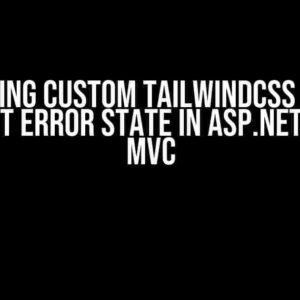Are you tired of struggling with passing complex data from your JavaScript application to your ASP.NET Core Web API controller? Do you find yourself stuck in the mud, unable to figure out how to send a serialized JSON payload from your client-side code to your server-side API? Fear not, dear developer, for today we’re going to explore the magical realm of JSON serialization and ASP.NET Core Web API controllers!
What is JSON Serialization?
JSON (JavaScript Object Notation) is a lightweight, human-readable data interchange format that’s widely used for exchanging data between web servers, web applications, and mobile apps. JSON serialization is the process of converting .NET objects into JSON data, which can then be transmitted over the wire and deserialized back into .NET objects on the receiving end.
Why Use JSON Serialization?
JSON serialization offers several benefits, including:
- : JSON is language-agnostic, meaning it can be used with any programming language, platform, or framework.
- : JSON is a text-based format that’s lightweight and easy to parse, making it ideal for high-performance data transfer.
- : JSON is a widely supported standard, making it easy to exchange data between different systems, services, and applications.
How to Serialize JSON Data in ASP.NET Core
Out of the box, ASP.NET Core provides excellent support for JSON serialization through the System.Text.Json NuGet package. This package provides a set of classes and interfaces for serializing and deserializing JSON data.
Serializing JSON Data Using JsonSerializer
To serialize JSON data using the JsonSerializer class, you’ll need to create an instance of the JsonSerializer class and call the Serialize method, passing in the object you want to serialize.
using System.Text.Json;
public class Person
{
public string Name { get; set; }
public int Age { get; set; }
}
public class Program
{
public static void Main()
{
var person = new Person { Name = "John Doe", Age = 30 };
var jsonSerializer = new JsonSerializer();
var json = jsonSerializer.Serialize(person);
Console.WriteLine(json);
}
}
In this example, we create a Person object and serialize it to JSON using the JsonSerializer class. The resulting JSON string is:
{"Name":"John Doe","Age":30}
Passing Serialized JSON Payload to an ASP.NET Core Web API Controller
Now that we’ve covered the basics of JSON serialization, let’s explore how to pass a serialized JSON payload to an ASP.NET Core Web API controller.
Creating an ASP.NET Core Web API Controller
First, let’s create an ASP.NET Core Web API controller that accepts a serialized JSON payload:
using Microsoft.AspNetCore.Mvc;
using System.Text.Json;
[ApiController]
[Route("api/[controller]")]
public class PersonsController : ControllerBase
{
[HttpPost]
public IActionResult CreatePerson([FromBody]Person person)
{
// Process the person object
return Ok(person);
}
}
In this example, we create a PersonsController class with a single CreatePerson action method. This method accepts a serialized JSON payload in the request body and deserializes it into a Person object using the [FromBody] attribute.
Sending a Serialized JSON Payload from the Client-Side
Next, let’s explore how to send a serialized JSON payload from the client-side using JavaScript and the Fetch API:
fetch('https://localhost:5001/api/Persons', {
method: 'POST',
headers: {
'Content-Type': 'application/json'
},
body: JSON.stringify({
Name: 'Jane Doe',
Age: 25
})
})
.then(response => response.json())
.then(data => console.log(data))
.catch(error => console.error('Error:', error));
In this example, we use the Fetch API to send a POST request to the PersonsController with a serialized JSON payload in the request body. The JSON.stringify() method is used to serialize the JavaScript object into a JSON string.
Deserializing JSON Payload in ASP.NET Core Web API Controller
When the ASP.NET Core Web API controller receives the serialized JSON payload, it’s automatically deserialized into a .NET object using the [FromBody] attribute:
[HttpPost]
public IActionResult CreatePerson([FromBody]Person person)
{
// person is now a deserialized Person object
return Ok(person);
}
In this example, the CreatePerson action method receives the deserialized Person object, which can then be processed and stored in a database or returned as a response.
Common Pitfalls and Solutions
When working with JSON serialization and ASP.NET Core Web API controllers, you may encounter some common pitfalls. Here are some solutions to help you overcome them:
| Pitfall | Solution |
|---|---|
| JSON serialization fails due to circular references | Use the ReferenceHandler.Preserve option to preserve circular references during serialization |
| JSON deserialization fails due to invalid JSON data | Use the [FromBody] attribute and ensure that the client-side JSON data is properly formatted and serialized |
| ASP.NET Core Web API controller does not accept JSON payload | Ensure that the Web API controller action method is decorated with the [HttpPost] attribute and that the request body contains a valid JSON payload |
By following these best practices and solutions, you can overcome common pitfalls and successfully pass serialized JSON payloads to your ASP.NET Core Web API controllers.
Conclusion
In this article, we’ve explored the magical realm of JSON serialization and ASP.NET Core Web API controllers. We’ve learned how to serialize JSON data using the JsonSerializer class, pass serialized JSON payloads to an ASP.NET Core Web API controller, and deserializes JSON payloads using the [FromBody] attribute.
By mastering the art of JSON serialization and ASP.NET Core Web API controllers, you’ll be able to build robust, scalable, and high-performance web applications that seamlessly exchange data between client and server.
So, go forth and serialize those JSON payloads with confidence!
Here are 5 Questions and Answers about “How to pass a serialized JSON payload to an ASP.NET Core Web API controller” in a creative voice and tone:
Frequently Asked Question
Get ready to unlock the secrets of sending serialized JSON payloads to ASP.NET Core Web API controllers!
Q1: What is the recommended way to pass a JSON payload to an ASP.NET Core Web API controller?
Use the [FromBody] attribute on the controller action parameter to specify that the data is coming from the request body. This tells ASP.NET Core to deserialize the JSON payload into the specified type.
Q2: How do I ensure that my JSON payload is properly serialized and deserialized in ASP.NET Core?
Make sure to use a JSON serializer like Newtonsoft.Json or System.Text.Json to serialize your data on the client-side, and configure ASP.NET Core to use the same serializer on the server-side. This ensures that the data is serialized and deserialized consistently.
Q3: Can I use a complex object as a parameter in my ASP.NET Core Web API controller action?
Yes, you can use a complex object as a parameter in your ASP.NET Core Web API controller action. The object will be deserialized from the JSON payload automatically. Just make sure the object’s properties match the JSON payload’s structure.
Q4: How do I handle errors when deserializing a JSON payload in ASP.NET Core?
Use the ModelState to validate the deserialized object. If the deserialization fails, the ModelState will contain error messages that you can return to the client. You can also use custom model binders to handle errors and exceptions during deserialization.
Q5: Are there any security considerations when passing a JSON payload to an ASP.NET Core Web API controller?
Yes, be mindful of security vulnerabilities like JSON injection attacks and deserialization vulnerabilities. Use secure deserialization mechanisms and validate user input to prevent attacks. Additionally, use HTTPS to encrypt the data in transit.


